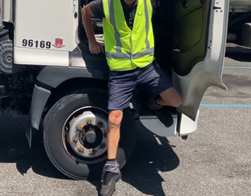
What are the risks?
Accounting for 218 claims over the past 5 years, machine operators are the second highest risk occupation for body stressing injury across the sector, behind parks and gardens.
This is due to several hazardous characteristics of the role, including sustained postures of the back and legs, highly repetitive movements of wrist, hands, fingers, awkward postures when operating or accessing/egressing, and exposure to whole body vibration.
Nationally it's estimated that 61.75% of truck drivers will develop musculoskeletal disorders (MSD) during their working life. This is unsurprising given the main risks for developing MSD injury are body stressing (injury from hazardous manual tasks) and slips, trips, missteps and falls.
From a Scheme perspective, LGIS is seeing an increase in injury claims caused by slips, trips, missteps and falls, accounting for 20% of total worker compensation claims and 40% of hazardous manual task related claims.
| Highest risk body parts | Highest risk job role | Highest risk age/s |
| Hip, Knee, ankle | Machine operators | 50 – 60 yrs |
| Shoulder, elbow, wrist | Parks and gardens | 60 – 70 yrs |
| Back | Other trade workers | 40 – 50 yrs |
Given the reliance of the WA local government sector on machine operators, essential education and ergonomic interventions are something we highly encourage you to engage with.
Whether you're a sweeper operator, roller operator, front-end loader operator, grader operator, waste operator, or one of the many other machine operators in our sector, we encourage you to stay current with the latest machinery ergonomics guidelines, and understand how better cab ergonomics can reduce your risk of injury. Our expert injury prevention consultants have put together a helpful video which will guide you through the best practical ergonomic and preventative strategies to mitigate the risk of future injury.
This video will help you to avoid injury with the correct set-up of seats, controls and levers, mirrors and cameras.
Watch the machinery ergonomics prevention video
Remember, that this is general advice only, be sure to always check your manufacturers manual, which should be available for all plant equipment for specific machinery use guidelines.
Available LGIS resources
- Machinery ergonomic self-assessment checklist.
- Operator stretching posters.
- Injury prevention workshops and machinery ergonomic assessments.
More Information
For members seeking further information on the best practices regarding machinery ergonomics you should contact your LGIS regional risk specialist or the injury prevention team.